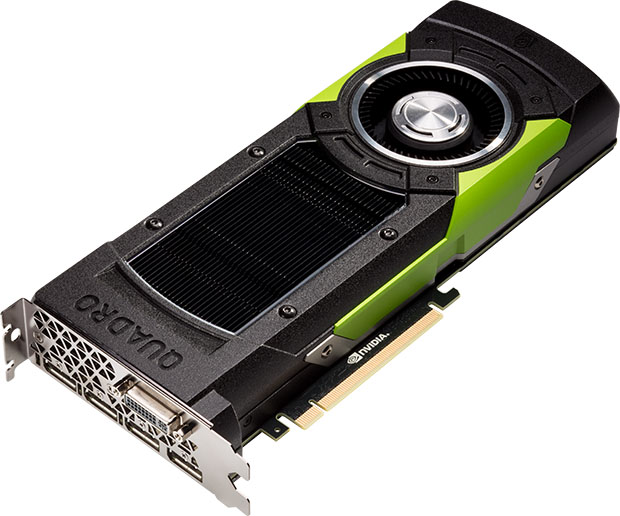NVIDIA Unleashes Quadro M6000 Workstation Graphics Powerhouse Based On Maxwell
NVIDIA released its Quadro M6000 at last week's GPU Technology Conference, but interestingly, it was without much fanfare. Perhaps that has something to do with the card belonging to the professional market and NVIDIA doesn't feel the need to trumpet in a new release, but this thing deserves that.
As the "M" in its name implies, this is a Maxwell-based Quadro - the first of its kind. Just as with the desktop GeForce series, the move from Kepler to Maxwell on Quadro offers a slew of benefits, from improved general performance (in some cases up to 2.5x) to increased power efficiency.

Specs-wise, the M6000 is effectively a GTX TITAN X, but clocked down ever-so-slightly. We're talking 3,072 CUDA cores, a 988MHz clock speed, and memory throughput of 317GB/s (vs. 336.5GB/s of TITAN X). And like the monstrous TITAN X, the M6000 features 12GB of memory and a 250W TDP.
While higher-end Kepler-based Quadro cards offered solid double-precision performance, the M6000 doesn't; it's 190 GFLOPS vs. the K6000's 1.7 TFLOPs. The reason for this is simple: NVIDIA decided to push the single-precision performance higher, since that's the major demand, and especially because that results in improved ray-tracing performance - something that NVIDIA's always taken seriously, but even more so this generation. In that comparison, the M6000 is close to 20% faster than the K6000, although real-world performance jumps greater than that can be seen depending on the scenario.
In recent years, NVIDIA's been pushing its Iray physically-based renderer hard as it believes it to be the most robust one available. Currently, Autodesk's 3ds Max, Revit, and Maya, as well as Rhinoceros, all support Iray. Later this year, NVIDIA will be releasing an even more robust Iray solution, tentatively called Iray+. A major feature this will enable is allowing customers to take advantage of cloud-based rendering, with NVIDIA's VCA appliances doing the churning (pictured above; and yes, that's 8x M6000s, resulting in 48.56 TFLOPs of single-precision performance).
To show off what's possible with the M6000, NVIDIA had a demo on-hand at GTC last week called "Death Ray". The subject is a real-life building in London named 20 Fenchurch Street, designed by Rafael Viñoly. Due to its design, which sees its front curved inward, the building acts like a mirror that concentrates sunlight and beams it towards a certain area. Most days, there's no problem, but when the issue became serious was when the beam of light struck a parked Jaguar on a neighboring street, burning the car and buckling some of its panels.
As crazy as that might be, the issue isn't limited to 20 Fenchurch Street. The building's same designer also built the Vdara hotel in Las Vegas, and it has similar problems - you don't want to be in the pool at the wrong time.
Is this design flaw the result of Rafael's negliglance? It's hard to say, but to his defense, had the tools he had available to him been able to tell him that such a thing would occur, the building could have been designed a little bit differently. You can see an example of such a tool in the shot above, which is a homebrewed NVIDIA demo. Being a physically-based render, how the sun hits the building in this demo is extremely accurate, and with it, the building's designer would have been able to spot the problem fast.
If you look close at the image above (it can be clicked to see a larger version), you can see the light beam concentrated on the street towards the right of the building. If the beam is strong enough to effectively melt parts of a car, I feel bad for the folks that live in the apartments surrounding its target area!
This is all no doubt impressive, but there's another M6000 feature that's well worth highlighting as well: Real-time ray-traced scene adjustments. For example, if a 3ds Max project is set to an ActiveShade window, you'll be able to manipulate the scene as you like, and as soon as you stop, this ActiveShade window will begin rendering the scene immediately. This is something that really has to be seen to be believed; it's one of those things that can make development work a lot less tedious, and the more M6000s installed (up to 4x in a single PC), the faster the noise will disappear from the scene. All of NVIDIA's demo PCs at GTC had dual M6000s installed, so it's hard for us to gauge the real-world performance of just a single card with a feature like this.
This is scratching the surface of what the Quadro M6000 brings to the table, but if you're already sold on it, be prepared to allocate about $5,000 per card. Not mentioned up to this point, the M6000 features 4x DisplayPort 1.2 ports, along with a DVI-I DL port, and can support resolutions up to 4096x2160 @ 60Hz.
Also at GTC, NVIDIA filled-out its Kepler Quadro series with the K1200, a $350 offering sporting 512 cores, a 4GB framebuffer, 80GB/s of memory bandwidth, and 4x mini-DP ports.



